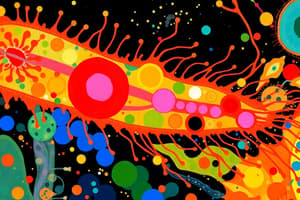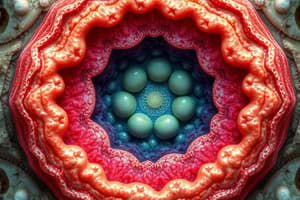Podcast
Questions and Answers
Which of the following characteristics is NOT typically associated with living organisms?
Which of the following characteristics is NOT typically associated with living organisms?
- Cellular organization
- Metabolism
- Photosynthesis (correct)
- Reproduction
Which classification rank directly follows the 'Family' level in the hierarchical system?
Which classification rank directly follows the 'Family' level in the hierarchical system?
- Species
- Phylum
- Genus (correct)
- Order
What is the primary function of the mitochondria in eukaryotic cells?
What is the primary function of the mitochondria in eukaryotic cells?
- Energy production (correct)
- Waste disposal
- Photosynthesis
- Protein synthesis
Which of the following statements about prokaryotic and eukaryotic cells is correct?
Which of the following statements about prokaryotic and eukaryotic cells is correct?
What role does the Golgi apparatus play in a eukaryotic cell?
What role does the Golgi apparatus play in a eukaryotic cell?
What is the outcome of mitosis in terms of chromosome number?
What is the outcome of mitosis in terms of chromosome number?
Which statement best describes lysosomes?
Which statement best describes lysosomes?
Cell membranes primarily function to:
Cell membranes primarily function to:
Flashcards
Cell - unit of life
Cell - unit of life
The basic building block of all living organisms, with diverse structures and functions.
Prokaryotic cell
Prokaryotic cell
A cell lacking a nucleus and other membrane-bound organelles.
Key characteristics of life
Key characteristics of life
Cellular organization, reproduction, metabolism, growth, response to stimuli, adaptation, and evolution are essential traits.
Eukaryotic cell
Eukaryotic cell
Signup and view all the flashcards
Cell membrane
Cell membrane
Signup and view all the flashcards
Mitochondria
Mitochondria
Signup and view all the flashcards
Cellular respiration
Cellular respiration
Signup and view all the flashcards
Cell division
Cell division
Signup and view all the flashcards
Study Notes
The Living World
- Living organisms exhibit a wide range of diversity, from microscopic bacteria to large mammals.
- Key characteristics defining a living entity include cellular organization, reproduction, metabolism, growth, response to stimuli, adaptation, and evolution.
- Classification of living organisms is based on shared characteristics, with a hierarchical system (Kingdom, Phylum, Class, Order, Family, Genus, Species) used to categorize them.
- The hierarchical system of classification aims to reflect evolutionary relationships among organisms
- Various classification methods have been used throughout history, reflecting changing understanding of life.
- Modern classification methods incorporate molecular data, particularly DNA sequencing.
Cell: The Unit of Life
- The cell is considered the fundamental unit of life. All living organisms are composed of cells.
- Cells exhibit remarkable structural and functional diversity, adapting to various roles in different organisms.
- Prokaryotic cells lack a membrane-bound nucleus and other organelles, while eukaryotic cells possess a nucleus and membrane-bound organelles.
- Major organelles in eukaryotic cells include the nucleus, mitochondria, endoplasmic reticulum, Golgi apparatus, lysosomes, vacuoles, and plastids (in plant cells).
- Each organelle has a specialized function within the cell.
- The nucleus houses the genetic material (DNA) of a eukaryotic cell.
- Mitochondria are responsible for cellular respiration, generating energy for cellular activities.
- The endoplasmic reticulum (ER) plays a crucial role in protein synthesis and lipid metabolism.
- The Golgi apparatus processes and packages proteins for secretion or use within the cell.
- Lysosomes act as the cell's waste disposal system.
- Vacuoles are storage sacs for water, nutrients, and waste products.
- Plastids, such as chloroplasts, are present in plant cells and are involved in photosynthesis.
- Cell membranes regulate the passage of substances into and out of cells.
- Cell walls, found in plant cells, provide structural support and protection.
- Cellular processes like respiration and photosynthesis involve complex chemical transformations.
- Cell division, a crucial process for growth and reproduction, occurs through mitosis and meiosis.
- The process of mitosis ensures that each daughter cell receives a complete set of chromosomes.
- Meiosis, essential for sexual reproduction, reduces the chromosome number to produce gametes (sperm and egg).
- Differences between plant and animal cells include the presence of a cell wall and plastids in plant cells.
- Modern cell biology utilizes advanced techniques like microscopy, biochemistry, and molecular biology to study the structure and function of cells.
- The study of cell structure and function is crucial for comprehending the intricate mechanisms of life.
Studying That Suits You
Use AI to generate personalized quizzes and flashcards to suit your learning preferences.
Description
This quiz explores the diversity of living organisms and the fundamental characteristics that define life. It covers classification systems, from historical methods to modern molecular approaches, and emphasizes the cell as the basic unit of life. Test your understanding of biology concepts related to organisms and cellular structure.




